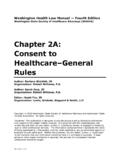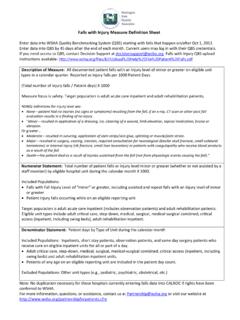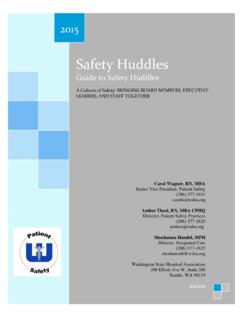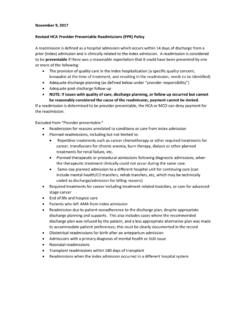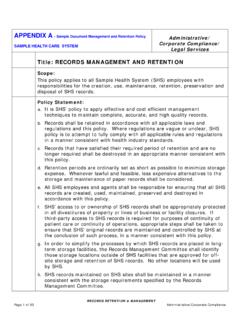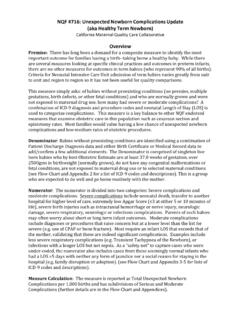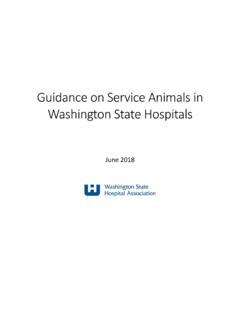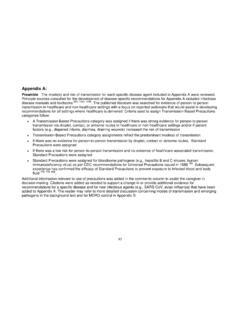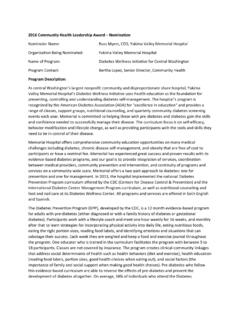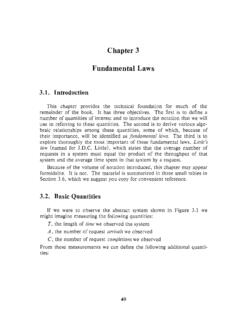Transcription of Ricky’s Law: Involuntary Treatment for Substance Use Disorders
1 Ricky s law : Involuntary Treatment for Substance Use DisordersJanuary 30, 2018 Washington State Hospital AssociationDepartment of Social and Health ServicesPresentersDivision of Behavioral Health and Recovery, Department of Social and Health Services: David Reed, Policy Development, Department of Social and Health Services Robby Pellett, Program Manager of Acute & Inpatient Care Washington State Hospital Association: Chelene Whiteaker, Senior Director, Policy Development Taya Briley, Executive Vice President, General CounselObjectives Help understand the new law Help hospitals plan for implementationResourcesWSHA Bulletin on Ricky s LawWebsite: in Managing SUD Patients under Ricky s LawHB 1713 Integration of Substance Use Disorders into the Involuntary Treatment ActWashington State Hospital AssociationHow did we get here?History of Chemical Dependency Commitments RCW Pilot Project Integrated Crisis Response (Secured Detox and CD detentions)RCW 2006-2009 How did we get here?
2 Ricky s (Ricky Garcia) Law Submitted to legislature in 2015 Primarily the efforts of one person: Lauren Davis Passed in 2016 as part of HB 1713HB 1713: Ricky s LawThe two primary tasks of the Department (DSHS):Create Designated Crisis Responders (DCRs)Ensure that at least one 16 bed secure detoxificationfacility is operational by April 1, 2018 and a second facility is operational by April 1, 2019 Current Practice DMHPs currently see about 70-92% co-occurring Substance induced psychosis cases go to E&Ts and clear.(Some DMHPs do not detain anyone found positive for a Substance . Some E&Ts refuse to accept anyone under the influence.) Ricky s law captures new population for Substance use DCR Training Will train about 450 DMHPs across the state to be DCRs Review of DSM- Substance Use Disorder criteria Review of ASAM Assessment criteria Review of Washington State Substance Use Disorder Treatment Risk assessment in the presence of a Substance Use Disorder Clinical practice discussions and petition writing Plan to provide quarterly DCR trainings ongoing for new hires Secure Withdrawal Management and Stabilization Facility (Secure Detoxification Facility)
3 Provide services at a similar level of an Evaluation and Treatment facility Detention equals the criteria for admission to a Secure Withdrawal Management and Stabilization FacilityFacility Design Up to an ASAM Level of Care Medically Monitored Intensive Inpatient Services Physician available to assess in-person within 24 hours of admission Nursing assessment on admission Medication prescription and monitoring Coordination of necessary services and discharge planning Planned regimen of professionally directed evaluation and Treatment services Availability of seclusion and restraintE&T Level of Care Examination and medical evaluation within 24 hours by a licensed physician, advanced registered nurse practitioner, or physician assistant certified Nursing assessment on admission Psychosocial evaluation by a mental health professional Development of an initial Treatment plan Consideration of less restrictive alternative Treatment Availability of seclusion and restraintProposed Secure Detox FacilitiesAmerican Behavioral Health Services Adults In Chehalis, Lewis County with 24 beds In Spokane with 24 bedsDaybreak Youth ServicesMinors In Vancouver WA with 3 beds Possibly in Spokane with 8 female youth-only bedsImplementationWho is involved?
4 DCR Teams BHOs/MCOs/ASOs Courts Secure Withdrawal Management and Stabilization Services ProvidersSUD Treatment Providers HospitalsLaw Enforcement RCW RCW (3) If a person is brought to the emergency room of a public or private agency or hospital for observation or Treatment , the person refuses voluntary admission, and the professional staff of the public or private agency or hospital regard such person as presenting as a result of a mental disorder or Substance use disorder an imminent likelihood of serious harm, or as presenting an imminent danger because of grave disability, they may detain such person for sufficient time to notify the designated crisis responder of such person s condition to enable the designated crisis responder to authorize such person being further held in custody or transported to an evaluation Treatment center, secure detoxification facility, or approved Substance use disorder Treatment program pursuant to the conditions in this chapter.
5 But which time shall be no more than six hours from the time the professional staff notify the designated crisis responder of the need for evaluation, not counting time periods prior to medical clearance. RCW (effective April 1, 2018)Emergency detention of persons with mental Disorders or Substance use Disorders (1) When a designated crisis responder receives information alleging that a person, as the result of a mental disorder, presents an imminent likelihood of serious harm, or is in imminent danger because of being gravely disabled, after investigation and evaluation of the specific facts alleged and of the reliability and credibility of the person or persons providing the information if any, the designated crisis responder may take such person, or cause by oral or written order such person to be taken into emergency custody in an evaluation and Treatment facility for not more than seventy-two hours as described in RCW (2)
6 When a designated crisis responder receives information alleging that a person, as the result of Substance use disorder, presents an imminent likelihood of serious harm, or is in imminent danger because of being gravely disabled, after investigation and evaluation of the specific facts alleged and of the reliability and credibility of the person or persons providing the information if any, the designated crisis responder may take the person, or cause by oral or written order the person to be taken, into emergency custody in a secure detoxification facility or approved Substance use disorder Treatment program for not more than seventy-two hours as described in RCW , if a secure detoxification facility or approved Substance use disorder Treatment program is available and has adequate space for the Legal Criteria Risk, signs and symptoms of a Substance Use Disorder Risk =Danger to Self, Others, Property, and Grave Disability SUD= Signs and Symptoms of Substance Use Disorder Examples May not need to be under the influence to meet criteria Intoxication from substances alone may not lead to detention History of patients with SUD will be importantSame Legal Timelines Designated Crisis Responder timelines 3 hour -MHP evaluation 6 hour If person comes to the ER on their own 12 hour If person is sent to ER by police 72 hour detention 14 day commitment 90 day less restrictive alternative DCR AssessmentMeets Criteria for Detentio nDoes Not Meet Criteria for Detentio nMeets Criteria for Detentio n and needs DetoxDoes Not Meet Criteria for Detentio nMental HealthSubstance UseAggressive AssaultiveAcute Medical NeedsCare Needs (Fall Risk, ADLs, Can t Transfer)Aggressive AssaultiveAcute Medical Needs (Detox or Medical Is sue)Care Needs (Fall Risk, ADLs, Can t Transfer)
7 E&T Level o f CareASAM Level of CareE&T Bed AvailableSingl e Bed Cert AvailableNo Bed AvailableVoluntary InpatientAppropriate Less RestrictiveMeets Criteria for Detentio nSecure Detox Bed AvailableSecure Detox Bed Not AvailableVoluntary DetoxResidential/OutpatientHos pital TreatmentAssess for Mental Health Detention under RCW No-Bed Report/Hos pital Hold under EMTALA/DischargeMeets Criteria for Detentio n but not DetoxNo single bed certification for Substance use Disorders Challenges Limited bed capacity as the number of Secure Withdrawal Management and Stabilization facilities slowly grows Long distances to transport to limited Secure Detox units Court differences Lack of medical detox facilities for severe Alcohol and Benzo withdrawalWSHA Legislative ApproachProblem: Concern about limited capacityTiming: Law takes effect in April after legislature adjournsWSHA approach: SB 6365/HB 2401 would suspend Ricky s law for patients with Substance use Disorders until more Treatment capacity can be developedBill link: Hospital refers, patient meets criteria to be involuntarily detained, but no bed and designated crisis responder cannot detain Patient initially appears to be a Substance use disorder patient, but there is no bed available and the patient presents a likelihood of harm or is gravely disabled as a result of a psychiatric condition A situation where the DCR has been called to evaluate a patient, but has not arrived in the timelinesWSHA with legal the EMTALA a out to other key administrative clinical the facts and circumstances of each individual , document, prepared for bumps, this is a new lawPlanning for Referrals When to refer under the new law Example WSHA recommendation.
8 Talk with your local BHO or the organization who has the crisis services contract in your regionPlanning for Long Waits for Evaluations Timelines for designated crisis responder s evaluations are the same as for mental health patients 6 hours 12 hoursEMTALA ConsiderationsQuestions
